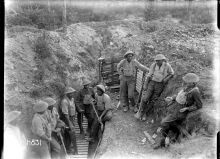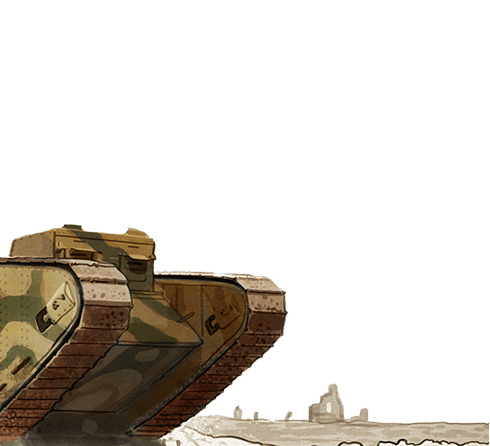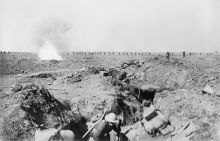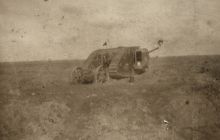Glossary
First World War & military vocabulary
Somme 1916
Army
An operational unit composed of two or more Army Corps and supporting units, often numbering several hundred thousand men.
Army Corps
An operational unit composed of two or more divisions and supporting units, numbering 30-40,000 men.
Bayonet
A blade or long knife attached to the end of a rifle and used by infantry. Originally a long, pointed spike that plugged into the barrel of a gun, the bayonet evolved into an additional weapon that allowed a soldier to charge, fire, and stab with his rifle. The bayonet became a standard part of a soldier's kit and was often used for purposes other than close-quarter combat such as eating or cutting material.
Casualty clearing station
A military medical facility situated behind the frontline, out of range of small arms and artillery fire. A casualty clearing station receives wounded soldiers from regimental aid posts and, once given the required medical treatment, sends the wounded to field hospitals for further treatment.
Creeping barrage
A pre-planned curtain of artillery fire designed to ‘creep forward’ in short, controlled bounds, often in front of advancing infantry.
Division
Numbering over 18,000 men, in 1916 the New Zealand Division consisted of 3 infantry brigades, 4 field artillery brigades, a mounted rifles regiment and numerous smaller engineer, signals, medical, labour, logistic, trench mortar and machine gun units. Supporting the Division in a non-combat role was a large administrative and support structure composed of medical, training and administrative units.
Dugout
A hole, dug into the ground and often built around with timber or other material to offer protection or shelter.
Entrenching tool
A short spade or digging tool used for ‘digging in’ or entrenching.
Field Artillery Batteries and Brigades
New Zealand Field artillery batteries consisted of either six 18-pounder field guns or six 4.5-inch howitzers. A field artillery brigade consisted of 3 batteries of 18-pounders and 1 battery of 4.5-inch howitzers. By 1916 four such field artillery brigades were included in the New Zealand Division, in addition to 1 heavy, 3 medium and 3 light trench mortar batteries.
Infantry Battalion
Infantry battalions were commanded by a lieutenant colonel and were composed of 4 companies. At full strength a battalion numbered over a thousand men, but would usually go into action with less than 800. After severe fighting battalion strengths could fall dramatically to as few as 300 or 400 men. Medical, signalling and logistics troops were also contained within a battalion.
Infantry Brigade
New Zealand Infantry brigades were composed of 4 infantry battalions and at full strength numbered over 4,000 men, commanded by a brigadier-general. Whereas British infantry brigades were reduced to only three battalions in 1918, New Zealand infantry brigades retained their 4-battalion strength throughout the war, making the New Zealand Division one of the strongest in the British and Commonwealth armies.
Infantry Company
Infantry companies were commanded by Majors or Captains and consisted of a small headquarters and 4 platoons, totalling about 227 men at full strength. 4 companies formed a battalion.
Infantry Sections and Platoons
The smallest tactical unit within an infantry battalion, the infantry section consisted of 12 men led by a non-commissioned officer. At the beginning of the war almost all infantry sections were composed exclusively of riflemen, but by 1918 they also contained specialised bombing and light-machine-gun personnel. 4 Sections were normally required to form an Infantry platoon commanded by a junior officer.
Lewis Gun
A light machine gun used by infantry and aircraft during the First World War. Invented by US Army Colonel Isaac Newton Lewis in 1911, the Lewis gun was manufactured in the United Kingdom by the Birmingham Small Arms Company. It was used predominantly throughout the British Empire and adopted by other armies.
Mills bomb
Named after William Mills, an English hand grenade designer, the Mills bomb, with its grooved, cast-iron design and distinctive ‘pineapple’ appearance, became the standard grenade used by the British Army and some of its allies during the First World War.
Mortar
Originally a short, wide type of cannon, the modern mortar is an artillery piece consisting of a firing tube, bipod mount, and baseplate. The Stokes Trench Mortar, introduced in 1915, was the first portable mortar and quickly proved to be a reliable weapon, capable of firing rounds directly into trenches from a high angle.
Mounted Rifles Regiment
Composed of 3 squadrons, each of 4 troops of 38 NCOs and troopers, the New Zealand Mounted Rifles Regiments initially numbered 550 men each trained in scouting and reconnaissance roles and as mobile reserves that would ride to the battle but go into action on foot. Only one regiment, the Otago Mounted Rifles, accompanied the newly formed New Zealand Division to the Western front and was soon reduced to a single squadron.
Webbing
Webbing is the belts, straps and pouches worn by British and Commonwealth soldiers.



